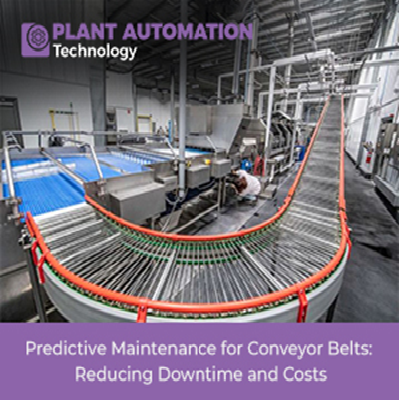Predictive Maintenance for Conveyor Belts: Reducing Downtime and Costs

Introduction
In modern industrial processes, conveyor belts have become the backbone of material handling and production operations. Whether in manufacturing, mining, logistics, or food processing, conveyor systems efficiently transport goods and materials, contributing to overall productivity and profitability. However, the breakdown of a critical conveyor belt can lead to costly downtime, disrupt workflows, and compromise operational efficiency. To address these challenges, forward-thinking industries are increasingly turning to predictive maintenance strategies for their conveyor belts. By leveraging advanced technologies and data analytics, predictive maintenance enables proactive identification of potential issues, reducing downtime, and ultimately cutting operational costs.
Predictive maintenance for conveyor belts is a proactive approach that utilizes real-time data, machine learning, and IoT technologies to identify potential equipment failures. By continuously monitoring critical parameters like temperature, vibration, and speed, predictive maintenance algorithms can detect early warning signs, reducing unscheduled downtime and ensuring smooth operations. This data-driven strategy allows industries to address maintenance needs during scheduled downtimes, leading to significant cost savings over time. Moreover, by maximizing the efficiency of conveyor systems, predictive maintenance enhances material flow and overall productivity. The implementation involves integrating IoT devices, upskilling employees in data analysis, and collaborating with predictive maintenance experts. Successful case studies in automotive manufacturing and food processing demonstrate the tangible benefits of predictive maintenance, including decreased downtime, increased production efficiency, and reduced maintenance costs. Embracing predictive maintenance ensures a competitive edge in today's fast-paced industrial landscape.
A) Understanding Predictive Maintenance for Conveyor Belts
Predictive maintenance for conveyor belts is a data-driven maintenance approach that utilizes real-time data, historical performance records, and machine learning algorithms to predict and prevent equipment failures. Instead of relying on a reactive maintenance model where maintenance is performed only when a problem arises, predictive maintenance empowers industries to anticipate maintenance needs and perform repairs or replacements at the most opportune times.
| Also Read: Efficiency in Motion: Conveyors & Conveying Equipment for Streamlined Operations |
The Benefits of Predictive Maintenance for Conveyor Belts
1. Reducing Downtime
Predictive maintenance offers a major advantage in reducing unscheduled downtime by continuously monitoring conveyor systems. Advanced algorithms in predictive maintenance can detect early warning signs of potential failures, allowing maintenance teams to intervene before any catastrophic breakdown occurs. This proactive approach effectively minimizes production halts and ensures smooth operations throughout the industrial processes.
| Also Read: The Transformative Role of Artificial Intelligence in Predictive Maintenance for Industrial Plants |
2. Cost Savings
Unplanned downtime can be extremely costly, not only in terms of lost production but also due to emergency repairs and rushed shipments to meet deadlines. Predictive maintenance helps companies avoid these expenses by addressing maintenance needs during scheduled downtimes or when production demand is lower, resulting in significant cost savings over time.
3. Increased Efficiency
Efficient conveyor belt systems are crucial for maintaining high productivity levels. By proactively addressing potential issues, predictive maintenance ensures that conveyor systems operate optimally, maximizing material flow and reducing delays. This, in turn, leads to increased efficiency and throughput.
| Also Read: Smart Strategies for Smooth Operations: Predictive Maintenance in Automation |
B) Key Components of a Predictive Maintenance Program
Data Collection and Analysis
Data collection and analysis form the cornerstone of a successful predictive maintenance program. By equipping critical conveyor components with advanced sensors and Internet of Things (IoT) devices, real-time data on essential parameters like temperature, vibration, and speed is gathered. This data is subsequently fed into machine learning algorithms, enabling the identification of patterns and trends that may indicate potential failures. Such proactive insights help prevent untimely breakdowns and optimize conveyor system performance.
Machine Learning and AI
Machine learning algorithms analyze historical performance data to build predictive models. These models can identify patterns and correlations between certain operating conditions and the likelihood of failures. As new data is continually fed into the system, the models become more accurate, enhancing the ability to predict maintenance needs.
Condition Monitoring
Regular condition monitoring of conveyor belt components is essential for predictive maintenance success. This involves visually inspecting critical parts, such as rollers, belts, bearings, and motor drives, and using non-destructive testing methods to detect early signs of wear or damage. The data obtained from condition monitoring informs maintenance decisions and helps prevent unexpected failures.
C) Implementing Predictive Maintenance
Integration of IoT Devices
The integration of IoT devices into conveyor belt systems enables seamless data collection and transmission. These devices provide real-time insights into equipment performance and health, allowing maintenance teams to make data-driven decisions efficiently.
|
Also Read: Improving Supply Chain Efficiency: Conveyor Belt Manufacturers and Automation Solutions |
Training and Skill Development
The successful implementation of predictive maintenance relies on skilled personnel capable of interpreting collected data and making informed decisions. To ensure the effective adoption of this strategy, providing training and upskilling employees in data analysis and predictive maintenance principles is crucial. Empowering the workforce with the right knowledge enhances the overall efficiency and effectiveness of the predictive maintenance approach.
Collaboration with Maintenance Service Providers
In some cases, industries may collaborate with maintenance service providers specializing in predictive maintenance. These experts bring in-depth knowledge and experience in analyzing complex data and implementing predictive maintenance strategies, providing valuable insights and support to optimize conveyor belt systems.
D) Case Studies of Successful Predictive Maintenance Implementations
Automotive Manufacturing
In the field of automotive manufacturing, a prominent industry player successfully implemented predictive maintenance for its conveyor belts. The results were remarkable, with a notable 30% reduction in downtime and a significant 20% increase in overall production efficiency. By promptly identifying and addressing potential issues before they could escalate into failures, the company streamlined its manufacturing process, saving valuable time and resources along the way. This achievement underscores the power and effectiveness of predictive maintenance in optimizing industrial operations and maximizing productivity.
Food Processing
A large-scale food processing plant incorporated predictive maintenance for its conveyor systems, leading to a 25% decrease in maintenance costs and a 15% reduction in unscheduled downtime. By accurately predicting maintenance needs and addressing them proactively, the plant enhanced its productivity and minimized disruptions to food production operations.
Conclusion
Predictive maintenance for conveyor belts is a transformative approach that empowers industries to take proactive measures to maintain their critical material handling systems. By leveraging real-time data, machine learning, and IoT technologies, companies can significantly reduce downtime, achieve cost savings, and enhance operational efficiency. Embracing predictive maintenance not only ensures the smooth functioning of conveyor belt systems but also provides a competitive advantage in today's dynamic industrial landscape.
In conclusion, predictive maintenance is the key to unlocking the full potential of conveyor belt systems in various industries. By adopting a proactive and data-driven approach, companies can reduce downtime, optimize efficiency, and save costs. Embracing advanced technologies like IoT and machine learning will pave the way for a more sustainable and productive future in the world of conveyor belt systems. By prioritizing predictive maintenance, industries can stay ahead of the competition and maintain their edge in today's fast-paced industrial landscape.







